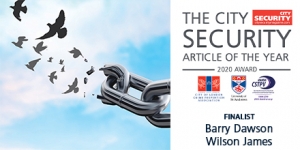The security sector and the new normal: protect & survive
 As lockdown restrictions are slowly lifted and London’s workforce begins to emerge, Barry Dawson, operations director at Wilson James, examines the impact the coronavirus pandemic has had on the capital’s security sector and how service providers are preparing for the ‘new normal’.
As lockdown restrictions are slowly lifted and London’s workforce begins to emerge, Barry Dawson, operations director at Wilson James, examines the impact the coronavirus pandemic has had on the capital’s security sector and how service providers are preparing for the ‘new normal’.
During this tumultuous period all aspects of our personal and work lives have changed. The coronavirus pandemic is having obvious implications for business continuity across the entire economy, and business in all industries and market sectors are adapting to a very different operational landscape. Security services providers are no exception and as the lockdown restrictions begin to ease, their role in protecting people is more critical than ever.
Pole position
The security services sector is well positioned to deal with these new challenges – identifying potential risks and managing them is what we do. However, there will be some fundamental differences to how this is achieved and, with the situation changing so rapidly, companies need to be flexible, agile and quick to react. Before people do return to their offices ‘en masse’, it must be safe enough for them to do so and effective systems have to be in place. Since lockdown was first announced, forward thinking organisations have spent time training their employees so that they can hit the ground running.
This has included knowledge provision on a broad range of subjects including furloughing, self-isolation, personal protective equipment, government guidance, and the ways physical security and technology can work together successfully. For example, a building’s access control and CCTV infrastructure will play a vital part in reducing bottlenecking, ensuring social distancing is implemented and allowing one-way system strategies to operate as intended.
In addition, relatively new systems such as CCTV cameras with thermal sensing are being used to identify those people entering a building who have a high temperature – a symptom of COVID-19. Some of these systems can even remotely read multiple individuals’ temperatures and use the cloud to share data in real time with security teams to keep buildings safe for operation.
Personal touch
Initially at least, employees returning to their places of work are likely to be nervous, apprehensive and uncertain. On top of that, a place that was previously familiar may now seem alien and there is likely to be some confusion about how any new operational policies work in practice. A security team’s ability to communicate in a way that is firm but friendly, calm, focused, clear and tactful will be imperative, particularly when approaching occupants who are inadvertently contravening social distancing guidelines.
Good communication is also a prerequisite when working with clients to develop policy and operational guidance, carry out risk assessments and define business continuity strategies. By adopting a customer service and concierge-style approach, security professionals can demonstrate a level of proactivity that assists any defined objectives.
For instance, Wilson James has initiated a system for one of its clients whereby a member of its team acts as an elevator operator, who is responsible for pressing the buttons and making sure that a lift is not overcrowded.
In many respects security personnel need to be the eyes and ears of a building by monitoring whether seating and workstations are suitably distanced, if space is being utilised properly and if there are any areas where people are congregating. Employee health and safety also depends on a hygienic work environment so workstations, conference rooms, collaborative areas, cafes, reception desks and other common areas must be monitored and cleaning staff notified to take immediate action if minimum standards are not met.
Close to home
The adoption of home working and the use of video conferencing technology have been two of the standout features of the coronavirus lockdown. While it’s too early to understand the full extent of the new skills and habits we’ve developed while working and communicating remotely, it’s reasonable to assume that this will continue to some extent once lockdown is fully lifted.
Security services providers have benefitted enormously from video conferencing technology as a way to communicate with clients and colleagues, which has been highly effective in making sure that relevant personnel are up to speed with any developments. Just as importantly, it has allowed meetings to be carried out to brainstorm, share ideas, exchange best practice tips, monitor workflows, build community, reinforce organisational culture, and strengthen colleague and client relationships.
There have also been less obvious benefits. While some people have easily adapted to home working, others have not. For this group of people video conferencing has offered a welcome level of human interaction and engagement, which has reduced their sense of isolation. It has also meant that those who are visibly struggling with lockdown can be more easily identified, and action taken to monitor their mental health and wellbeing.
Next step
The coronavirus pandemic has raised the profile of security within organisations and service providers need to start planning for when people return to their clients’ workplaces in greater numbers. As the security industry adapts to the ‘new normal’ we must not forget that pre-coronavirus threats still exist and must not be ignored, but be in a position to adapt to fundamental changes in the way we work, as well as workplace design and operation.
Barry Dawson
Operations Director, Wilson James
See also Creating a resilient security operation: The Crick Institute
Related articles in our Business Continuity category

